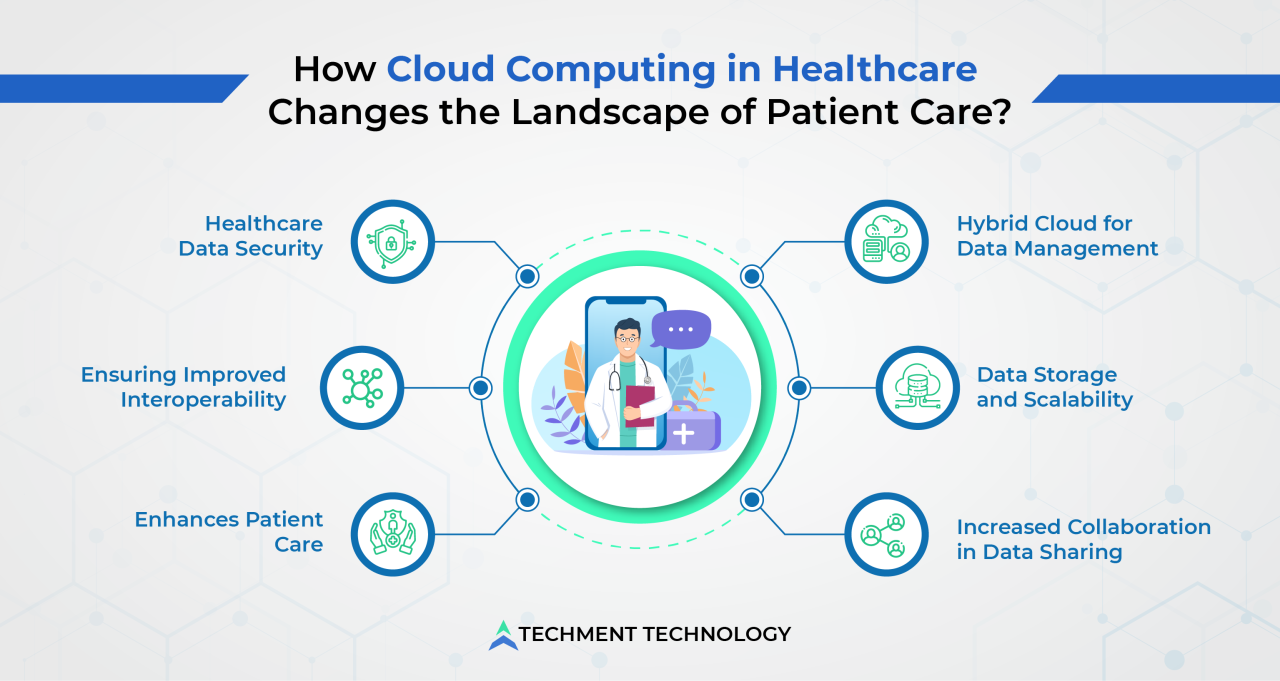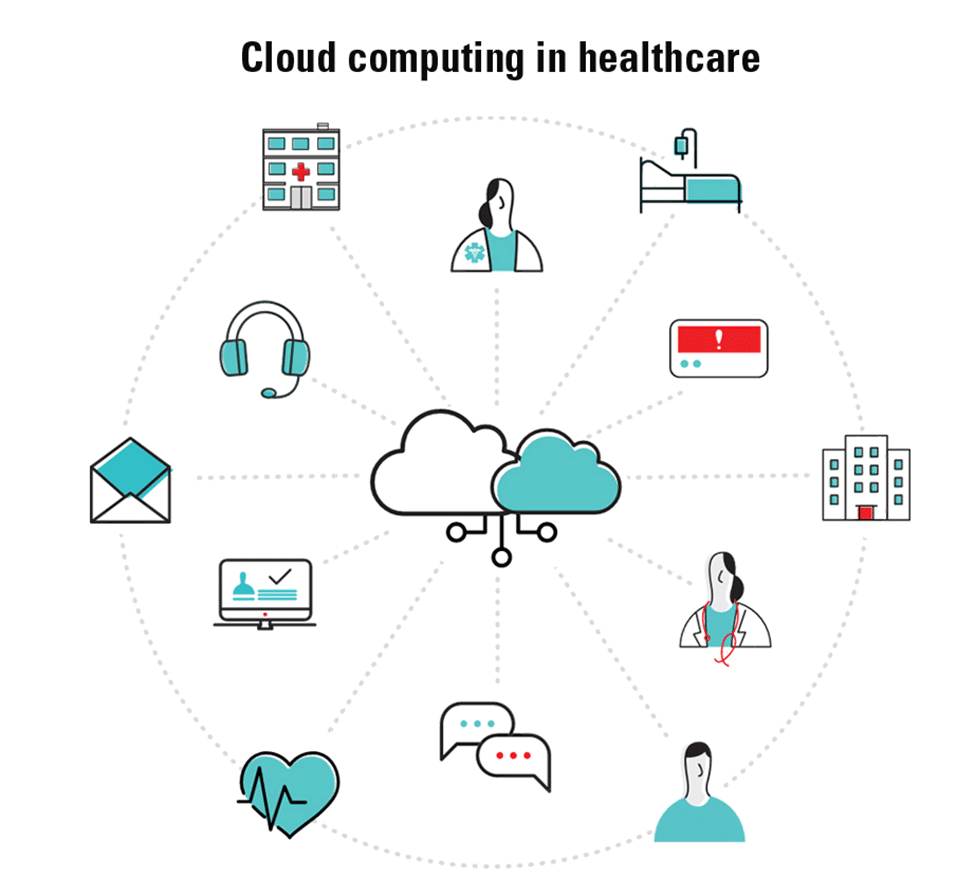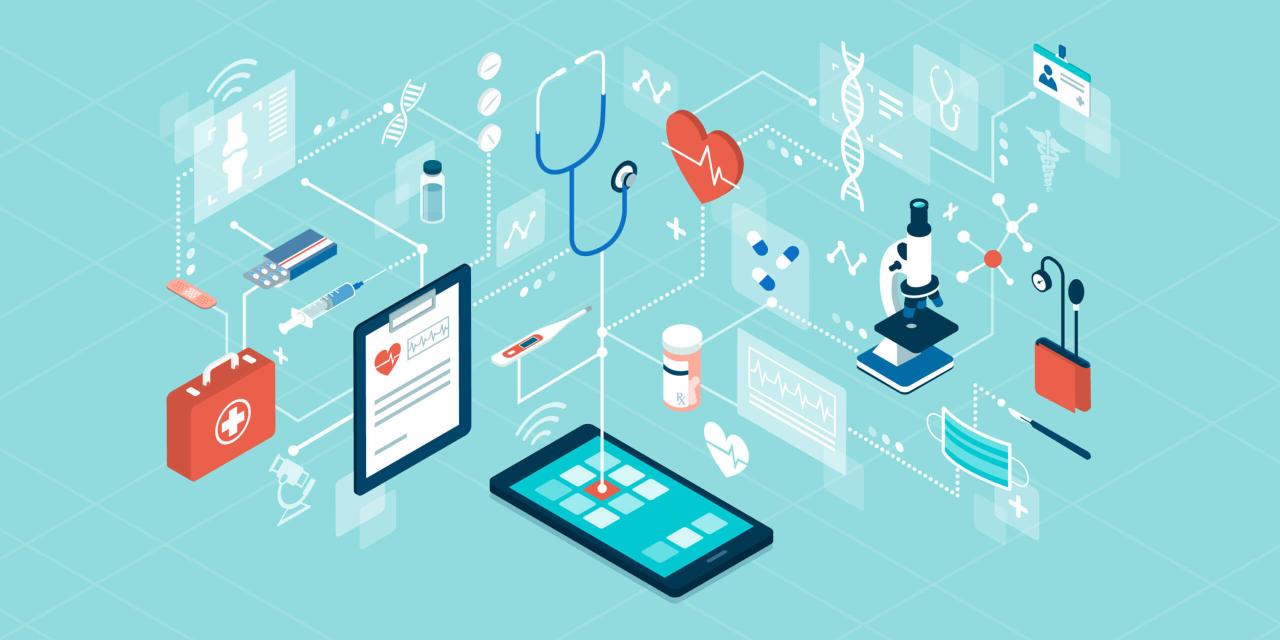Cloud computing in healthcare is revolutionizing how we deliver, manage, and access medical information. This transformative technology offers unprecedented opportunities for improved patient care, enhanced collaboration among providers, and streamlined operational efficiencies. From cost-effective storage solutions to advanced analytics capabilities, the cloud is reshaping the landscape of healthcare, presenting both exciting possibilities and significant challenges.
This exploration delves into the multifaceted aspects of cloud adoption in healthcare, examining the benefits, security concerns, diverse applications, and the future trajectory of this rapidly evolving field. We’ll discuss crucial topics such as data security and compliance, the integration of artificial intelligence, and the potential for cost optimization strategies.
Applications of Cloud Computing in Healthcare
Cloud computing has revolutionized various sectors, and healthcare is no exception. Its scalability, cost-effectiveness, and accessibility have enabled significant advancements in patient care, operational efficiency, and research. This section will explore several key applications of cloud computing within the healthcare industry, highlighting its impact on efficiency and comparing its performance to traditional methods.
Telehealth Applications
Telehealth, the remote delivery of healthcare services, has been significantly enhanced by cloud computing. Cloud-based platforms provide the infrastructure for secure video conferencing, data storage, and electronic health record (EHR) access, facilitating virtual consultations, remote monitoring, and even remote surgery. For example, a patient in a rural area can receive a consultation from a specialist in a major city without the need for extensive travel. This improves access to care, especially for patients in underserved communities. Cloud-based telehealth platforms offer better scalability than traditional on-premise systems, readily adapting to fluctuating demand during peak periods like flu season. Furthermore, cloud solutions often provide superior security features, including data encryption and access control, minimizing the risk of data breaches compared to less secure local networks.
Remote Patient Monitoring
Remote patient monitoring (RPM) utilizes wearable sensors and connected devices to collect patient data, such as heart rate, blood pressure, and glucose levels. This data is then transmitted to the cloud for analysis and alerts. Cloud computing facilitates real-time monitoring and early detection of potential health issues, enabling proactive interventions and preventing hospital readmissions. For instance, a patient with congestive heart failure can have their weight and blood pressure monitored daily, with alerts sent to their physician if any abnormalities are detected. This allows for timely adjustments to medication or treatment plans, preventing serious complications. Compared to traditional methods of manual data collection and analysis, cloud-based RPM systems offer significantly improved efficiency and accuracy. The automated nature of data transmission and analysis minimizes human error and allows for a more timely response to changes in a patient’s condition.
Medical Imaging
Cloud computing has transformed medical imaging by providing scalable and cost-effective solutions for storage, analysis, and sharing of medical images. Radiologists can access and interpret images from anywhere with an internet connection, improving collaboration and reducing turnaround times for diagnoses. For example, a hospital in a remote location can securely share images with a specialist in a different city for a second opinion, significantly reducing diagnostic delays. Cloud-based medical imaging systems often offer advanced analytics capabilities, such as artificial intelligence (AI)-powered image analysis, that can improve diagnostic accuracy and efficiency. Traditional methods of storing and sharing medical images, such as using physical storage media or local servers, are significantly less efficient and scalable. Cloud-based solutions offer superior performance in terms of accessibility, speed, and security, particularly when handling large volumes of high-resolution images.
Examples of Cloud-Based Healthcare Tools and Functionalities
Cloud computing underpins a wide array of healthcare tools. The following list provides some examples:
- Epic EHR: A comprehensive electronic health record system offering functionalities such as patient scheduling, clinical documentation, billing, and reporting.
- Cerner Millennium: Another widely used EHR system with similar capabilities to Epic, including integration with various healthcare applications.
- Amazon Comprehend Medical: An AI-powered natural language processing service that extracts relevant information from clinical notes and other unstructured data.
- Google Cloud Healthcare API: A set of APIs that enable developers to build healthcare applications using Google Cloud’s infrastructure.
- Microsoft Azure Healthcare APIs: Similar to Google Cloud Healthcare API, offering a range of tools for building healthcare applications on Azure.
These are just a few examples, and the landscape of cloud-based healthcare tools is constantly evolving.
Performance and Reliability Comparison: Cloud vs. Traditional
Let’s consider two scenarios: a small clinic and a large hospital system. A small clinic using a traditional on-premise system might struggle to manage its IT infrastructure, potentially leading to downtime and data loss. A cloud-based solution would provide greater reliability and scalability, adapting easily as the clinic grows. In contrast, a large hospital system with its massive data storage and processing needs would find cloud computing indispensable. Traditional solutions would struggle to provide the necessary scalability and performance, while a cloud-based system could easily handle the volume and complexity of data, offering superior performance and reliability. In both scenarios, cloud computing offers enhanced security through robust access controls and data encryption, mitigating risks compared to less secure on-premise systems.
Interoperability and Data Exchange in Cloud Healthcare

The seamless exchange of patient data is paramount in modern healthcare. Cloud computing offers significant potential to improve interoperability, but also presents unique challenges. Achieving true interoperability requires addressing issues of data standardization, security, and the integration of diverse systems. This section explores these challenges and opportunities, highlighting the role of cloud computing and best practices for successful implementation.
Cloud computing facilitates data exchange by providing a centralized, scalable, and accessible platform for storing and sharing patient information. This centralized approach contrasts with traditional, siloed healthcare systems, which often struggle with data sharing due to disparate technologies and formats. Cloud platforms can integrate various systems, enabling healthcare providers to access a comprehensive view of a patient’s medical history regardless of where the data originated. This integrated approach improves care coordination and decision-making.
Cloud computing is revolutionizing healthcare, offering improved data storage and accessibility. This is largely due to the impactful innovations highlighted in the article discussing Cloud Computing Trends Shaping the Future , which underscores the growing importance of scalability and security. These trends directly benefit healthcare providers by enabling efficient data management and facilitating better patient care through improved collaboration and analysis.
Challenges of Data Interoperability in Cloud-Based Healthcare Systems
Data interoperability in cloud-based healthcare faces several hurdles. Inconsistent data formats across different healthcare systems remain a major obstacle. Security and privacy concerns regarding sensitive patient data are also paramount. Ensuring compliance with regulations like HIPAA in the US or GDPR in Europe is critical and adds complexity. Finally, the integration of legacy systems with newer cloud-based solutions can be technically challenging and resource-intensive. These challenges necessitate careful planning and robust implementation strategies.
Opportunities Presented by Cloud Computing for Data Exchange
Cloud computing presents numerous opportunities to overcome these interoperability challenges. Cloud-based platforms can offer standardized data formats and APIs, simplifying data exchange between different systems. Robust security features inherent in many cloud platforms help protect sensitive patient data. Scalability allows healthcare organizations to handle increasing volumes of data as their needs grow. Furthermore, cloud-based solutions can reduce the IT infrastructure costs associated with maintaining on-premise systems, freeing up resources for other initiatives.
Best Practices for Ensuring Data Interoperability and Standardization in Cloud Healthcare
Implementing a well-defined data governance framework is crucial. This includes establishing clear data standards, access controls, and data quality procedures. Adopting standardized data exchange formats like FHIR (Fast Healthcare Interoperability Resources) is essential for seamless data sharing. Regular audits and security assessments are necessary to ensure compliance with regulations and maintain data integrity. Finally, choosing a cloud provider with a strong security track record and experience in healthcare is vital.
Comparison of Data Exchange Standards and Their Suitability for Cloud-Based Healthcare Systems
Several standards exist for exchanging healthcare data. FHIR, developed by HL7, is gaining significant traction due to its flexibility and RESTful API-based approach, making it well-suited for cloud environments. Other standards, like DICOM (Digital Imaging and Communications in Medicine), are used primarily for medical imaging data. The choice of standard depends on the specific needs of the healthcare organization and the type of data being exchanged. FHIR’s ability to integrate with various systems and its support for granular data access make it a strong contender for cloud-based healthcare interoperability. For example, a hospital system using FHIR can easily share patient allergies with a pharmacy system, ensuring medication safety. In contrast, DICOM’s focus on medical imaging makes it less versatile for other types of data.
Cloud Computing and Telemedicine

Cloud computing has revolutionized healthcare, and its impact on telemedicine is particularly profound. The scalability, accessibility, and cost-effectiveness offered by cloud platforms have fueled the rapid growth and enhanced the effectiveness of remote healthcare services, transforming how patients access care.
Cloud-based platforms provide the infrastructure necessary for a wide range of telemedicine applications, improving both patient care and provider efficiency. This shift towards remote care is particularly significant in addressing geographical limitations, increasing access for underserved populations, and enhancing the efficiency of healthcare systems.
Remote Patient Monitoring Enabled by Cloud Platforms
Cloud computing underpins the ability to remotely monitor patients’ vital signs and other health data. Wearable sensors and connected medical devices transmit data to cloud-based platforms, where it is stored, analyzed, and made accessible to healthcare providers. This allows for proactive intervention, early detection of health deteriorations, and improved management of chronic conditions. For instance, a patient with congestive heart failure can have their weight, blood pressure, and heart rate monitored daily, with alerts sent to their physician if any concerning trends emerge. The cloud’s scalability allows for the management of data from thousands of patients concurrently, providing real-time insights into population health trends.
Virtual Consultations and Cloud-Based Platforms, Cloud computing in healthcare
Cloud-based platforms facilitate secure video conferencing, enabling virtual consultations between patients and healthcare providers. These platforms often incorporate features like screen sharing for reviewing medical images, secure messaging for asynchronous communication, and electronic health record (EHR) integration for seamless access to patient information. This reduces the need for in-person visits, saving time and money for both patients and providers, while simultaneously expanding access to specialized care, particularly in rural or underserved areas. A cardiologist located in a major city can now easily conduct virtual consultations with patients across the state, offering specialized expertise without requiring patients to travel significant distances.
Remote Diagnostics through Cloud-Based Systems
Cloud computing enables the development and deployment of sophisticated remote diagnostic tools. Medical images, such as X-rays and CT scans, can be stored and analyzed on cloud-based platforms, allowing radiologists and other specialists to remotely review and interpret results. Artificial intelligence (AI) algorithms can be integrated into these platforms to assist in the diagnostic process, improving accuracy and efficiency. For example, a cloud-based AI system could analyze retinal images to detect early signs of diabetic retinopathy, enabling timely intervention and preventing vision loss. This capability significantly reduces the time needed for diagnosis and allows for faster patient treatment.
Scalability and Security Challenges and Opportunities in Cloud-Based Telemedicine
The scalability and security of cloud-based telemedicine platforms are critical considerations. The platforms must be able to handle increasing volumes of data and users as the adoption of telemedicine grows. Robust security measures are essential to protect patient data from unauthorized access and breaches. However, the inherent scalability of cloud computing offers a significant advantage in handling the increasing demands of a growing telemedicine user base. Implementing stringent security protocols, including data encryption, access controls, and regular security audits, mitigates security risks. Furthermore, adherence to relevant healthcare regulations, such as HIPAA in the United States, is crucial.
Secure and Scalable Cloud Architecture for a Telemedicine Platform
A secure and scalable cloud architecture for a telemedicine platform would incorporate several key components. A multi-tenant cloud environment would allow for efficient resource utilization and cost optimization. Data would be encrypted both in transit and at rest, ensuring confidentiality and integrity. Access control mechanisms would restrict access to patient data based on roles and permissions. The platform would integrate with existing EHR systems, enabling seamless data exchange and interoperability. Regular security audits and penetration testing would identify and address vulnerabilities. Redundancy and disaster recovery mechanisms would ensure high availability and business continuity. The architecture would leverage serverless computing for scalability and cost-effectiveness, automatically scaling resources based on demand. Finally, robust monitoring and logging capabilities would provide insights into system performance and security events.
Future Trends in Cloud Computing for Healthcare

The healthcare industry is on the cusp of a significant transformation driven by advancements in cloud computing. Beyond the current applications, several emerging trends promise to revolutionize healthcare delivery, data management, and patient care in the coming years. These advancements are not merely incremental improvements; they represent a fundamental shift in how healthcare data is stored, processed, and utilized. This section explores these key trends and their projected impact.
Edge Computing in Healthcare
Edge computing, processing data closer to its source rather than relying solely on centralized cloud servers, offers significant advantages for healthcare. In remote areas with limited or unreliable internet connectivity, edge devices can process critical patient data locally, enabling real-time monitoring and analysis even without a robust network connection. For example, a remote patient monitoring system using edge computing could transmit vital signs data to a local device for immediate analysis, triggering alerts only if necessary, conserving bandwidth and ensuring timely interventions. This reduces latency and improves the responsiveness of applications, particularly crucial in time-sensitive situations such as emergency care. Furthermore, edge computing enhances data security by minimizing the amount of sensitive information transmitted over potentially vulnerable networks.
Serverless Computing’s Role
Serverless computing, a form of cloud computing where providers dynamically manage servers, offers scalability and cost-effectiveness for healthcare applications. This architecture eliminates the need for healthcare organizations to manage their own servers, reducing IT infrastructure costs and allowing them to focus on core healthcare functions. Serverless functions are particularly well-suited for event-driven tasks such as processing patient data uploads or triggering alerts based on specific conditions. For instance, a hospital could use serverless functions to automatically process medical images upon upload, triggering notifications to radiologists for immediate review. This allows for efficient scaling of resources; during peak hours, more functions can be invoked to handle increased workload, while during off-peak times, resource usage is minimized, resulting in significant cost savings.
Blockchain Technology and Healthcare Data
Blockchain technology, known for its secure and transparent data management capabilities, presents a transformative potential for healthcare. Its decentralized and immutable nature makes it ideal for managing sensitive patient data, ensuring data integrity and privacy. Imagine a patient’s medical record stored on a blockchain, accessible only with their consent and securely shared with authorized healthcare providers. This enhanced security and transparency could improve interoperability, streamline data exchange, and foster greater trust between patients and healthcare providers. The potential for improved clinical trial management and supply chain tracking is also significant, ensuring transparency and accountability throughout the entire process. However, challenges remain in terms of scalability and regulatory compliance.
Predicted Evolution of Cloud Computing in Healthcare (2024-2034)
The following timeline illustrates the anticipated evolution of cloud computing in healthcare over the next decade:
| Year | Key Developments | Examples |
|---|---|---|
| 2024-2026 | Widespread adoption of hybrid cloud models; increased focus on data security and privacy regulations. | More hospitals adopting a combination of on-premise and cloud solutions for optimal data management. |
| 2027-2029 | Significant growth in AI and machine learning applications powered by cloud computing; increased use of edge computing for remote patient monitoring. | AI-powered diagnostic tools becoming more prevalent; widespread use of wearable devices connected to cloud-based platforms for remote patient monitoring. |
| 2030-2034 | Mature blockchain implementations for secure data sharing; widespread adoption of serverless computing for cost-effective scalability; personalized medicine driven by cloud-based analytics. | Secure, blockchain-based patient data exchanges becoming the norm; hospitals utilizing serverless functions for various tasks; personalized treatment plans generated based on individual patient data analysis. |
The integration of cloud computing into healthcare is undeniably reshaping the industry, promising a future of enhanced patient care, improved operational efficiency, and data-driven decision-making. While security and compliance remain paramount concerns, the potential benefits – from cost savings and scalability to the advancements in AI and telemedicine – are too significant to ignore. The ongoing evolution of cloud technology ensures that healthcare providers will continue to find innovative ways to leverage its power, ultimately leading to better health outcomes for all.
